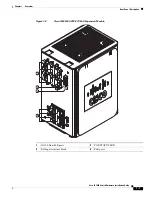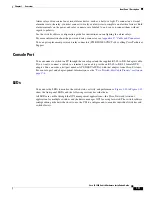
1-15
Cisco IE 3000 Switch Hardware Installation Guide
Chapter 1 Overview
Front-Panel Description
Power Status LED
The switch can operate with one or two DC power sources. Each DC input has an associated LED that
shows the status of the corresponding DC input. If power is present on the circuit, the LED is green. If
power is not present, the LED color depends on the alarm configuration. If alarms are configured, the
LED is red when power is not present; otherwise, the LED is off.
If the switch has dual power sources, the switch draws power from the power source with the higher
voltage. If the one of the DC sources fails, the alternate DC source powers the switch, and the
corresponding power status LED is green. The power status for the failed DC source is either off or red,
depending on the alarm configuration.
lists the power status LED colors and meanings.
Note
The Pwr A and Pwr B LEDs show that power is not present on the switch if the power input drops below
the low valid level. The power status LEDs only show that power is present if the voltage at the switch
input exceeds the valid level. The difference, or
hysteresis,
ensures that the power status LEDs do not
oscillate at values near 18 V.
For information about the power LED colors during the power-on self-test (POST), see the
Switch Operation” section on page 2-13
10/100 Port Status LEDs
Each 10/100 port has a port status LED, also called a port LED, as shown in
,
and
displays LED information about the switch and the individual ports.
Table 1-6
Power Status LEDs
Color
System Status
Off
Power is not present on the circuit, or the system is not powered up.
Green
Power is present on the associated circuit.
Red
Power is not present on the associated circuit, and the power supply alarm is
configured.
Table 1-7
10/100 Port Status LEDs
Color
System Status
Off
No link.
Solid green
Link present.
Blinking green Activity. Port is sending or receiving data.
Blinking
amber
A link blocked by Spanning Tree Protocol (STP) is
sending or receiving data.















































